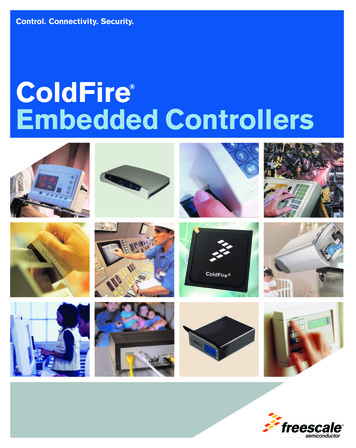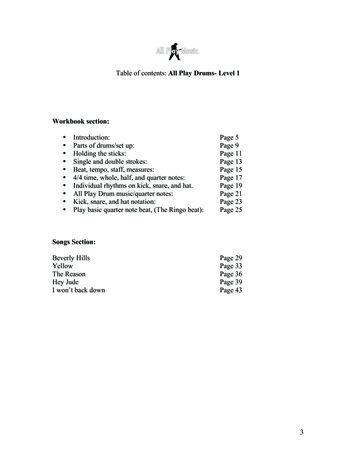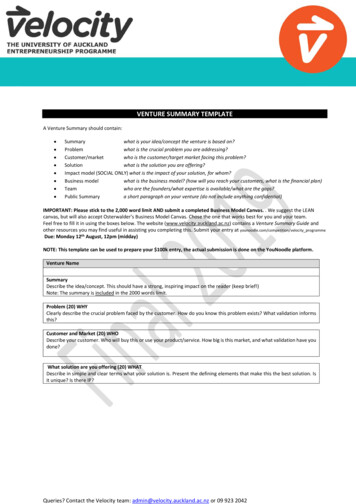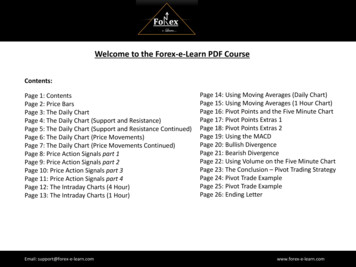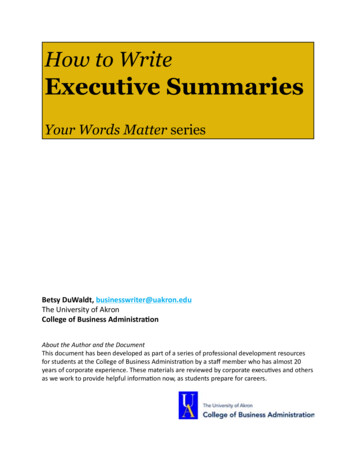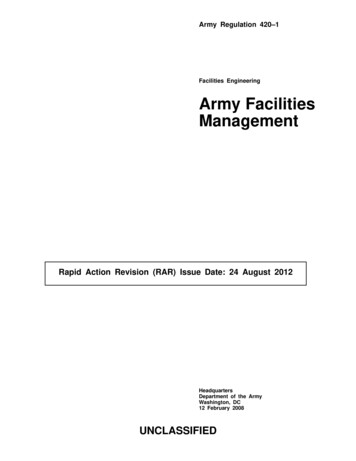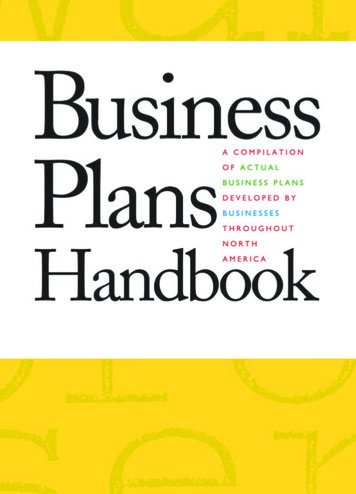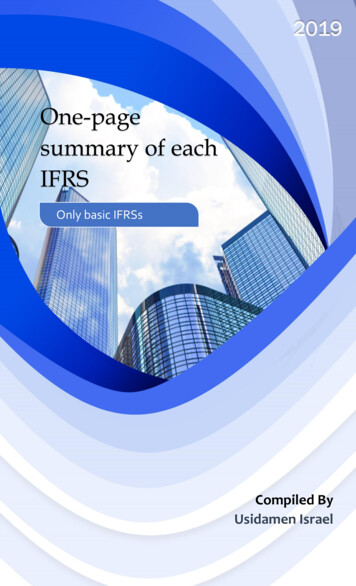
Transcription
2019One-pagesummary of eachIFRSOnly basic IFRSsCompiled ByUsidamen Israel
One-page summary of each IFRS (A basic guide), 2019.Compiled by Usidamen IsraelAbout this publicationThe objective of this publication is to help students and professionals get an overviewof what the IFRS entails. If you already have a good knowledge of the IFRSs, thispublication would give you a “bird’s eye view” of each IFRS and an avenue to betterappreciate its’ usefulness in our everyday accounting. If you are a student, who ispreparing for one accounting exam or the other, while using this publication alonewould likely not be sufficient for preparation, it would be useful for revising andretaining the knowledge already gained during intensive study, as it provides afoundation on which a more comprehensive study of the IFRS can be built.This publication is part of an annual compilation on financial reporting and auditingput together by the author, Usidamen Israel. It is updated every year to reflectdevelopments in the IFRSs and feedback from readers.Should you find any error, technical or grammatical, or have any suggestion(s) onhow we can improve this material for its next publication, do feel free to contact me(contact details can be found on the next page). Also feel free to share this materialwith as many persons as possible. Print and distribute it as you deem fit; however,note that it is not for sale!1 Page
About the authorUsidamen Israel is a professional accountant and mentor. His career as a professional accountantmajorly cuts across teaching and public practice.Israel teaches Financial Reporting at Wyse Associates Limited. He is also a visiting teacher atWiderange Professionals, Arepo, Ogun State. Before joining Wyse, he taught Financial Reportingand Corporate Reporting at Students Pye, Yaba, Lagos. He assists students preparing forexaminations conducted and organized by the Institute of Chartered Accountants of Nigeria (ICAN)and is well known for his patient, explanatory, jovial, pictorial and simple teaching style.As a professional accountant in practice, Israel started his career with Ayodele Olatunji & Co.(AOPS) before joining J. A. Olawin & Co. (Chartered accountants), whose Managing Partner, JAO, ispopular among ICAN students and professional accounting practitioners alike. He worked with JAOfor two and a half years during which he gained majority of his experience in taxation and auditing.He currently works in the audit line of service in one of the big 4 accounting firms.As an ICAN student, he won three prizes with the Institute, including a prize for the 2nd best overallqualifying student during the May 2013 professional examinations (PE 2). These days, he considershimself a mentor and friend to younger, up and coming professional accountants, most of whomare his professional students, who look up to him to share his experiences, knowledge,methodologies and tips as they strive towards acing their examinations and forging theirrespective careers. So far, he has been able to build excellent relationships with a lot of them, whichhas helped shape their lives and careers positively.He is the co-founder of Accounting Yard, a professional accounting movement (See next page).You can follow him on LinkedIn, where he frequently shares tips about learning and acquiringtechnical accounting knowledge and skills.2 Page
One-page summary of each IFRS (A basic guide), 2019.Compiled by Usidamen IsraelAccounting Yard (AY)Accounting Yard (AY) is a professional accounting movement with the objective(s) to: Motivate and encourage professionals (particularly accountants) to inculcate a culture oflearning Share current updates in the world of accounting and finance. Share current job updates specifically relating to accounting and finance Share knowledge relating to accounting and finance. Provide a platform for accountants to connect and network with one another, build andnurture valuable relationships.Since its inception, AY has been able to touch the lives of a number of accountants and continuesto represent a platform to meet and reunite with fellow professional colleagues. AY is constantlyevolving from a learning movement to a valuable network of key professionals within theaccounting and finance practice and you need to be a part of it.To be a part of this movement, you can join through any of the following means:1. Join any of our Whatsapp/Telegram groups.2. Follow our Whatsapp Stories (if you are interested, send a chat to 07066171338 with theword “Interested”) or3. Follow Accounting Yard on Instagram, Twitter or Facebook3 Page
CONTENTSA BRIEF INTRODUCTION TO IFRS . 6NEW STANDARDS/CHANGES INTRODUCED IN 2017 .7STANDARDS THAT ARE EFFECTIVE FROM 1 JANUARY 2018 . 9AMENDMENTS THAT ARE EFFECTIVE FROM 1 JANUARY 2018 . 9THE INTERNATIONAL ACCOUNTING STANDARDS BOARD (IASB) . 11OFF THE RECORD: OTHER INTERNATIONAL INFLUENCES . 12THE IASB CONCEPTUAL FRAMEWORK (ICF) . 13OFF THE RECORD: THE APPLICATION OF THE ICF IN THE DEVELOPMENT OF IFRSS . 14IASB PROPOSED REVISION TO THE CONCEPTUAL FRAMEWORK . 15OFF THE RECORD: DIFFERENCES BTW THE EXISTING CF & THE PROPOSED CF . 16IAS 8: ACCOUNTING POLICES, CHANGES IN ACCOUNTING ESTIMATES & ERRORS. 17CHANGING APs RETROSPECTIVELY . 17IAS 1: PRESENTATION OF FINANCIAL STATEMENTS (FSs) . 19IAS 2: INVENTORIES . 20IAS 7: STATEMENT OF CASH FLOWS .22OFF THE RECORD: DIRECT METHOD (DM) VS INDIRECT METHOD .23IAS 10: EVENTS AFTER THE REPORTING PERIOD (EARP) . 24COMMON PITFALL 1: IDENTIFYING THE AUTHORISATION DATE OF THE FS .25IAS 12: INCOME TAXES . 26COMMON PITFALL: COMPUTATION OF DEFERRED TAX (DT) .27IAS 16: PROPERTY, PLANT AND EQUIPMENT . 28IAS 17: LEASES . 29IFRS 16: LEASES . 30OFF THE RECORD: SOME DIFFERENCES BETWEEN IAS 17 & IFRS 16 . 31IAS 18 REVENUE (HAS BEEN SUPERSEDED BY IFRS 15) .32IFRS 15: REVENUE FROM CONTRACTS WITH CUSTOMERS (EFFECTIVE FROM 1 JANUARY 2018) .33DIFFERENCES BETWEEN IAS 18 (AND OTHER REVENUE RECOGNITION IFRSS) AND IFRS 15 . 34IAS 20: ACCOUNTING FOR GOVERNMENT GRANTS AND DISCLOSURE OF GOVERNMENT ASSISTANCE .35OFF THE RECORD: ACCOUNTING TREATMENT OF GOVERNMENTGRANTS .35IAS 23: BORROWING COSTS .37THE COMPUTATION OF BORROWING COSTS (BC) ELIGIBLE FOR CAPITALISATION .37IAS 24: RELATED PARTY DISCLOSURES . 39IDENTIFYING RELATED PARTY RELATIONSHIPS . 40RELATED PARTY DISCLOSURES. 40IAS 27: SEPARATE FINANCIAL STATEMENTS . 41IAS 28: INVESTMENT IN ASSOCIATES AND JOINT VENTURES (JVs) . 42IAS 32: FINANCIAL INSTRUMENTS: PRESENTATION. 43A BASIC UNDERSTANDING OF WHAT FIs MEAN. . 44SPLITTING COMPOUND FIs . 44IAS 33: EARNINGS PER SHARE (EPS) . 45IAS 36: IMPAIRMENT OF ASSETS . 46IAS 37: PROVISIONS, CONTINGENT LIABILITIES & CONTINGENT ASSETS . 474 Page
One-page summary of each IFRS (A basic guide), 2019.Compiled by Usidamen IsraelHOW TO IDENTIFY AN OBLIGATION . 48MEASUREMENT OF PROVISION WHEN THE TIME VALUE OF MONEY IS MATERIAL. 48IAS 38: INTANGIBLE ASSETS (IAS) . 49IAS 39: FINANCIAL INSTRUMENTS: RECOGNITION & MEASURMENT . 50EFFECTIVE INTEREST RATE (EIR) VS COUPON RATE . 51IFRS 9: FINANCIAL INSTRUMENTS .52OFF THE RECORD: DIFFERENCES BETWEEN IAS 39 AND IFRS 9 .53IAS 40: INVESTMENT PROPERTY (IP) .53IFRS 1: FIRST TIME ADOPTION OF IFRSS .55IFRS 3: BUSINESS COMBINATIONS (BCS) . 56COMPUTATION OF GOODWILL . 56IFRS 5: NON-CURRENT ASSETS HELD FOR SALE AND DISCONTINUED OPERATIONS (DOS) . 58COMMON PITFALL 1: CLASSIFICATION OF NON-CURRENT ASSETS AS HELD FOR SALE . 58IFRS 7: FINANCIAL INSTRUMENTS: DISLCOSURES. 60IFRS 8: OPERATING SEGMENTS . 61RELATIONSHIP BETWEEN AN OPERATING SEGMENT & A REPORTABLE SEGMENT . 62AGGREGATION OF THE QUANTITATIVE THRESHOLD. 62IFRS 10: CONSOLIDATED FINANCIAL STATEMENTS . 63IFRS 11: JOINT ARRANGEMENTS . 64IFRS 12: DISCLOSURE OF INTERESTS IN OTHER ENTITIES . 65HOW TO JOIN THE WHATSAPP GROUP . Error! Bookmark not defined.5 Page
A brief introduction to IFRSI will start this section by making this clear: the IFRSs are not bastards! They have parents just like you,where Mr. IASB (International Accounting Standards Board) is the father and Mrs. Conceptual Frameworkis the mother. Together, they conceive the accounting standards (IFRSs: International Financial ReportingStandards and IASs: International Accounting Standards). As of date, there are over 40 of them and chancesare there will be even more as time goes on.In technical terms, the IASB “primarily” follows a principle based approach in developing and amendingaccounting standards, and the principle it applies is referred to as the Conceptual Framework (CF). The CFis, therefore, not an accounting standard, rather it puts the accounting standards in context andsignificantly informs the way and manner in which they are developed.In summary, the IASB in conjunction with the CF conceive the IFRSs, which are then applied in thepreparation and presentation of financial statements. However, on some occasions the CF is applieddirectly in preparing and presenting the financial statements (See IAS 8).See diagram below:TheParentTheIFRSsTheFinancialStatements6 Page
One-page summary of each IFRS (A basic guide), 2019.Compiled by Usidamen IsraelQuick catch-up!Changes introduced in 2018Areas affectedBrief description of the changeEffective dateIAS 19, EmployeebenefitsAmendments relate to Plan Amendment, Curtailment or Settlementare as follows: If a plan amendment, curtailment or settlement occurs, itis now mandatory that the current service cost and the netinterest for the period after the remeasurement aredetermined using the assumptions used for theremeasurement. In addition, amendments have been included to clarify theeffect of a plan amendment, curtailment or settlement onthe requirements regarding the asset ceiling.Applicable to annualreporting periodsbeginning on or after 1January 2019.Early application ispermitted but must bedisclosed.Issued 7 February 2018IASB ConceptualFramework (CF)The major changes (compared to the 2010 IASB ConceptualFramework) are: Objectives of financial statements and the definition of areporting entity. Revised definitions of an asset and a liability. New guidance on measurement and derecognition,presentation and disclosure.The revised IASB Conceptual Framework has eight (8) chapters.Issued 29 March 2018.IFRS 3, BusinesscombinationsAmendments to IAS1 and IAS 8Amendment to the definition of a business Previous definition of a business: An integrated set ofactivities and assets that is capable of being conductedand managed for the purpose of providing a return in theform of dividends, lower costs or other economic benefitsdirectly to investors or other owners, members orparticipants. New definition of a business: An integrated set ofactivities and assets that is capable of being conductedand managed for the purpose of providing goods orservices to customers, generating investment income (suchas dividends or interest) or generating other income fromordinary activities.Issued 22 October 2018The changes in Definition of MaterialPrevious definition: Material Omissions or misstatements of itemsare material if they could, individually or collectively, influence theeconomic decisions that users make on the basis of the financialstatements.New definition: Information is material if omitting, misstating orobscuring it could reasonably be expected to influence decisionsthat the primary users of general purpose financial statementsmake on the basis of those financial statements, which providefinancial information about a specific reporting entity.7 PageThe revised CF is effectiveimmediately for the IASBand the IFRSIC.It has an effective date of1 January 2020—withearlier applicationpermitted—forcompanies that use theCF to develop accountingpolicies when no IFRSapplies to a particulartransaction.Companies are requiredto apply the amendeddefinition of a business toacquisitions that occur onor after 1 January 2020.Earlier application ispermitted.The amendments areeffective for annualreporting periodsbeginning on or after 1January 2020. Earlierapplication is permitted.
Tentative decision todefer the IFRS 17effective dateAt its meeting held in London, the IASB discussed the effectivedate of IFRS 17 'Insurance Contracts' and tentatively decided todefer it to annual periods beginning on or after 1 January 2022.The IASB also tentatively decided to defer the fixed expiry datefor the temporary exemption to IFRS 9 in IFRS 4 by one year sothat all insurance entities must apply IFRS 9 for annual periods onor after 1 January 2022.The previous effective date for IFRS 17 was annual reportingperiods beginning on or after 1 January 2021.Amendment to theIFRS Foundation’sConstitutionIssued 14 November 2018The Constitution sets out the objectives and governancearrangements of the IFRS Foundation and its standard-settingbody, the International Accounting Standards Board.Effective from 1December 2018.The amendments to the Constitution set the maximum tenure ofthe Trustee Chair and Vice-Chairs to nine years, clarify that theChair can be appointed either from among the Trustees orexternally, and specify that the Vice-Chairs must be appointedfrom the Trustee ranks. Previously, in accordance with paragraph10 of the Constitution, both the Chair and the Vice-Chair shall beappointed by the Trustees from among their number.Issued 29 November 20188 Page
One-page summary of each IFRS (A basic guide), 2019.Compiled by Usidamen IsraelGet ready!!Accounting standards that are effective from 1 January 2019StandardBrief descriptionIFRS 16, LeasesIFRS 16 specifies how an IFRS reporter will recognise, measure, present and disclose leases. Thestandard provides a single lessee accounting model, requiring lessees to recognise assets andliabilities for all leases unless the lease term is 12 months or less or the underlying asset has alow value. Lessors continue to classify leases as operating or finance, with IFRS 16’s approach tolessor accounting substantially unchanged from its predecessor, IAS 17.Issued 13 January 2016Interpretation standards that are effective from 1 January 2019InterpretationsIFRIC 23 Uncertaintyover Income TaxTreatmentsBrief descriptionThe interpretation specifically addresses: Whether tax treatments should be considered collectively Assumptions for taxation authorities' examinations The determination of taxable profit (tax loss), tax bases, unused tax losses, unused tax creditsand tax rates The effect of changes in facts and circumstancesIssued 7 June 2017Amendments that are effective from 1 January 2019InterpretationsBrief descriptionPrepaymentFeatures withNegativeCompensation(Amendments toIFRS 9)Amends the existing requirements in IFRS 9 regarding termination rights in order to allowmeasurement at amortised cost (or, depending on the business model, at fair value through othercomprehensive income) even in the case of negative compensation payments.Long-term Interestsin Associates andJoint Ventures(Amendments to IAS28)Clarifies that an entity applies IFRS 9 Financial Instruments to long-term interests in an associateor joint venture that form part of the net investment in the associate or joint venture but to whichthe equity method is not applied.AnnualImprovements toIFRS Standards2015–2017 CycleMakes amendments to the following standards:Issued on 12 October 2017.Issued on 12 October 2017 IFRS 3 and IFRS 11 - The amendments to IFRS 3 clarify that when an entity obtains control ofa business that is a joint operation, it remeasures previously held interests in that business.The amendments to IFRS 11 clarify that when an entity obtains joint control of a businessthat is a joint operation, the entity does not remeasure previously held interests in thatbusiness.IAS 12 - The amendments clarify that all income tax consequences of dividends (i.e.distribution of profits) should be recognised in profit or loss, regardless of how the tax arises.IAS 23 - The amendments clarify that if any specific borrowing remains outstanding after therelated asset is ready for its intended use or sale, that borrowing becomes part of thefunds that an entity borrows generally when calculating the capitalisation rate ongeneral borrowings.Issued 12 December 20179 Page
IAS 19, EmployeebenefitsAmendments relate to Plan Amendment, Curtailment or Settlement are as follows: If a plan amendment, curtailment or settlement occurs, it is now mandatory that thecurrent service cost and the net interest for the period after the remeasurement aredetermined using the assumptions used for the remeasurement. In addition, amendments have been included to clarify the effect of a plan amendment,curtailment or settlement on the requirements regarding the asset ceiling.Issued 7 February 201810 P a g e
One-page summary of each IFRS (A basic guide), 2019.Compiled by Usidamen IsraelTHE INTERNATIONAL ACCOUNTING STANDARDS BOARD (IASB)BRIEF HISTORY OF THE IASB The journey started in June 1973 when the International Accounting Standards Committee (IASC) was established byaccountancy bodies from ten (10) countries.By year 2000, the IASC expanded to accommodate over 100 countries with 163 bodiesThe Standards developed and issued by the IASC were referred to as International Accounting Standards (IAS) whilethe interpretation standards (i.e. SIC interpretations) were developed by the Standing Interpretations Committee (SIC).The IASC developed and issued 41 accounting standardsIn 2001, the IASC was replaced by the International Accounting Standards Board while the SIC was replaced by theInternational Financial Reporting Interpretation Committee (IFRIC)-now referred to as IFRS Interpretations Committee(IFRSIC). This change was done to improve the independence, legitimacy and quality of the standard setting process.The IASB is part of an independent commission referred to as the IFRS Foundation.The Standards developed and issued by the IASB are called IFRS, while interpretation standards issued by the IFRSICare IFRSIC interpretations.At its first meeting in 2001, the IASB adopted all outstanding IASs issued by the IASC as its own Standards, although,some of these Standards have been superseded, therefore, when referring to IFRS, that term includes IFRS, IAS,SIC and IFRSIC interpretations.Differences between the IASB and the IASCAreas of differencesIASBIASCIndependenceofthe governing bodyA group of Trustees with diverse geographicand functional background who areindependent of the accounting professionIndividuals are appointed based ontechnical skills & background experienceGoverned by an IASC Board which combinedthe work of standard setting with the overalloperations of the IASC.Appointment is based on representatives ofspecial national accountancy bodies or otherorganisationsThe IASC usually meets four times in a yearLesser technical and commercial staffMembersBoardofBoard meetingsNumber of stafftheThe IASB usually meets each monthThe IASB have more technical andcommercial staffSTRUCTURE OF THE IASB The IASB has a three-tier governance structure made up of the IFRS Monitoring Board (for public accountability), theIFRS Foundation trustees (for governance) and the IASB (the independent standard setting body). IFRS Monitoring Board is a group of capital market authorities and provides a formal link between the Trustees andpublic authorities in order to enhance the public accountability of the IFRS Foundation. The Trustees are responsible for the governance and oversight of the IASB, including Constitution and due process fordevelopment of the accounting Standards. It’s part of their duty to source for fund and involve in day to day operations. The IASB is the independent standard-setting body of the IFRS Foundation. The IFRS Interpretations Committee isthe interpretative body of the IASB, which works with the Board in supporting the application of IFRS Standards. Supporting the IASB and Trustees is the IFRS Advisory Council which provides advice and counsel to the Trustees andthe IASB, whilst the IASB also consults extensively with a range of other standing advisory bodies and groups.OBJECTIVES OF THE IASB1. To develop, in the public interest, a single set of high quality financial reporting standard based on a “clearlyarticulated principles”. The IASB Conceptual Framework (ICF) represents the principle in the IFRS.2. To promote the use and rigorous application of those standards.3. In fulfilling objectives (a) and (b) to take account of the needs of a range of sizes and types of entities in diverseeconomic settings. This objective gave rise to IFRS for SMEs.4. To work with national accounting standards (NASs) setters to converge NASs with the IFRSs.IASB STANDARD SETTING PROCESS1. The staff are asked to identify and review all the issues associated with the topic and consider the ICF.2. Consult the Trustees and the Advisory Council about the advisability of adding the topic to the IASB agenda.3. Publishing for public comment a discussion document (DD) and an exposure draft (ED)4. Publishing an ED containing basis for conclusions and the alternative views of IASB members who opposes the ED.5. Consideration of all comments received within the comment period on the DD and the ED.6. Approval and publishing of a standard. The published standard would contain a basis of conclusion and dissentingopinions of other IASB members.11 P a g e
OFF THE RECORD: OTHER INTERNATIONAL INFLUENCESApart from the IASB and the Conceptual Framework, other international bodies still have one or two ingredients they addto the IFRS. Under this section, we would be identifying some of these international bodies as well as specific areas of theIFRS in which they have added their ingredient.InternationalTheir influence on the IFRSbodiesFinancial AccountingStandards Board(FASB)The FASB is the American Accounting standard setter. In May 2005, the FASB signed an agreementwith the IASB called the “Norwalk Agreement”. It was called such because the place where it wassigned was Norwalk in South Western Connecticut, USA. Through the agreement, both partiesworked on the IFRS to converge it with the American Account Standards (Financial AccountingStandards). The Americans have an accounting culture of making their standards rules based,whereas, IFRS is majorly (not entirely) principles based.As a result of the “American Flavor”, IFRS 8, Operating Segment set some specific quantitativethreshold in determining a reportable segment, although, it still gave some room for discretionwhen determining operating segments.The InternationalOrganisation ofSecurities Commission(IOSCO)IOSCO represents the world’s securities markets regulators, it currently has over 200 members fromover 115 jurisdictions regulating over 95% of the world’s securities market. Financial statements arevery vital to the integrity of the securities market, hence, the need for the IOSCO to work with theIASB.In 1995, a "core standard agreement” was signed between IOSCO and the defunct IASC. Theagreement committed the IASC to the completion of revisions to the standards that IOSCO deemedessential if it was to permit IAS based financial reporting in the securities market under its memberscontrol and after the fulfilment of this agreement in 1998, in year 2000, the IOSCO recommendedto all its members that they allow multinational users to submit FSs based on IFRS.The IOSCO works closely with the IASB in developing IFRSs, it particularly played a key role in thedevelopment of IAS 39, Financial instruments: Recognition and measurement the predecessor to IFRS9.European Union (EU)EU Directives issue directives from time to time and such Directives brought about the developmentof certain IFRSs e.g. SIC 7, Introduction of the Euros, IFRIC Interpretation 6, Liabilities arising fromspecific market-waste electrical and electronic equipment12 P a g e
One-page summary of each IFRS (A basic guide), 2019.Compiled by Usidamen IsraelTHE IASB CONCEPTUAL FRAMEWORK (ICF)To ensure that the IASB develops IFRSs in a logical manner this conceptual framework was developed.PURPOSE AND STATUSa.b.c.d.e.To assist the IASB in the development of future IFRSs and in its review of existing IFRSs.To assist national standard-setting bodies in developing national standards.To assist auditors in forming an opinion on whether financial statements (FSs) comply with IFRSs.To assist preparers of FSs in applying IFRSs & in dealing with topics yet to be covered by any IFRS.To provide interested parties with information about the IASB’s approach to the development of IFRSs.CHAPTER 1: THE OBJECTIVE OF GENERAL PURPOSE FINANCIAL REPORTING (GPFR)The objective of GPFR is to provide financial information about the reporting entity that is useful to users in making decisi
IASB (International Accounting Standards Board) is the father and Mrs. Conceptual Framework is the mother. Together, they conceive the accounting standards (IFRSs: International Financial Reporting Standards and IASs: International Accounting Standards). As of date, there are over 40 of them



